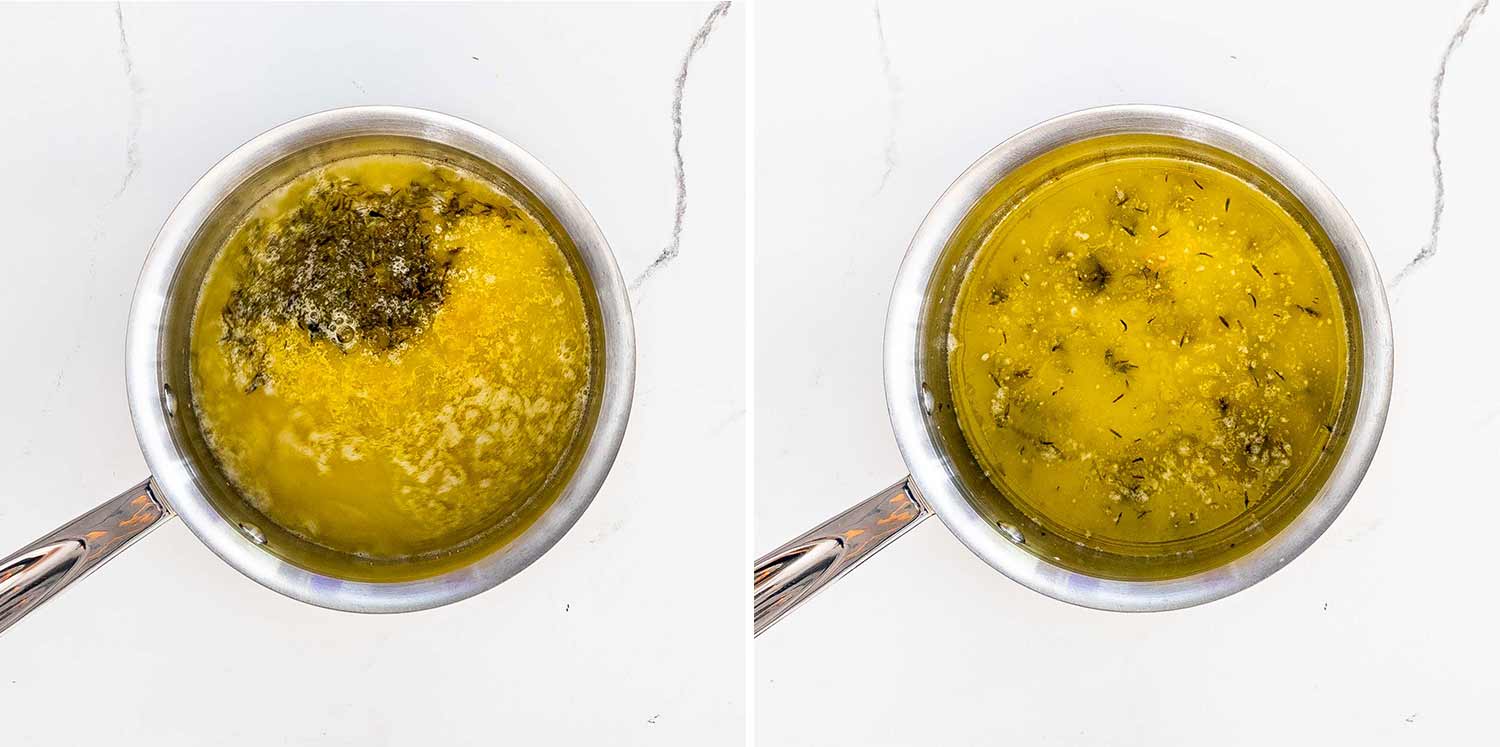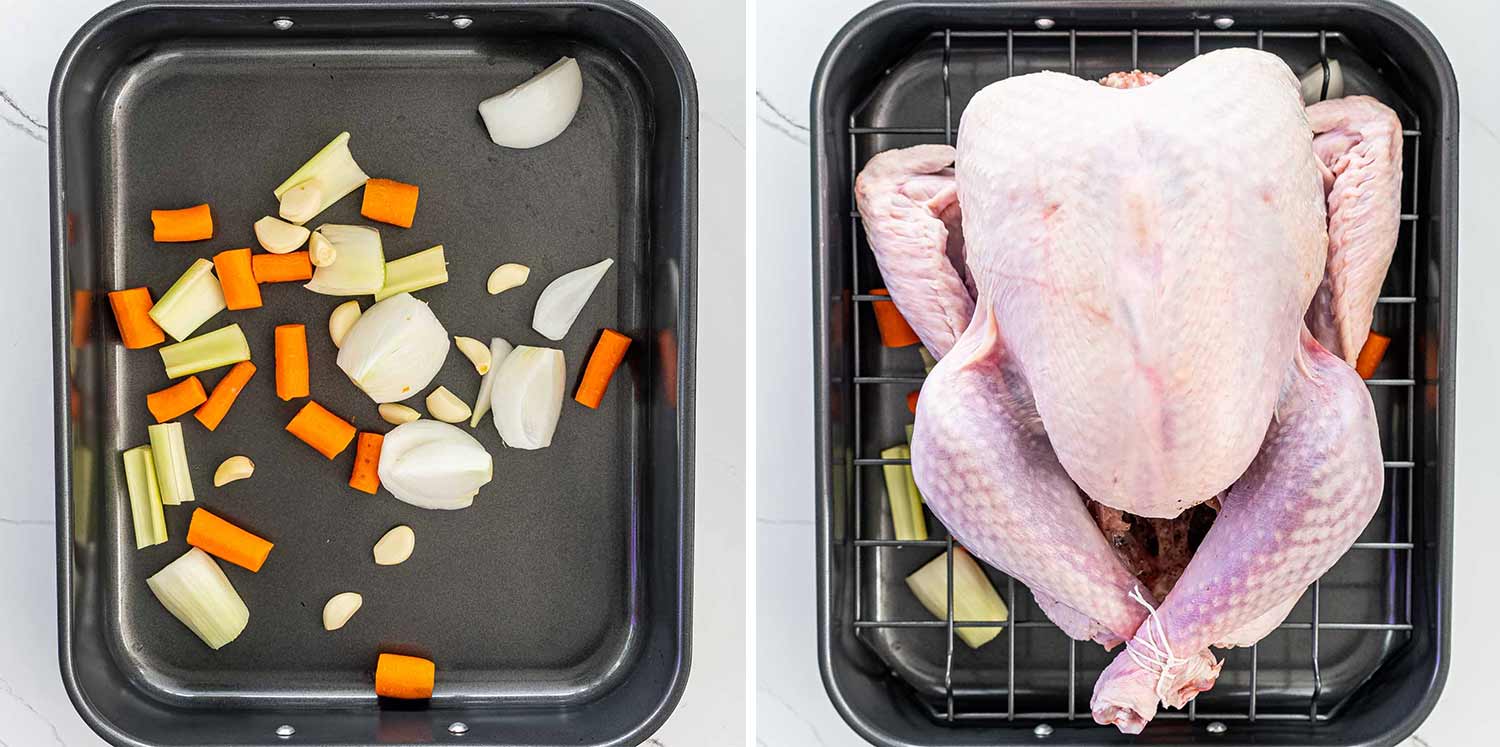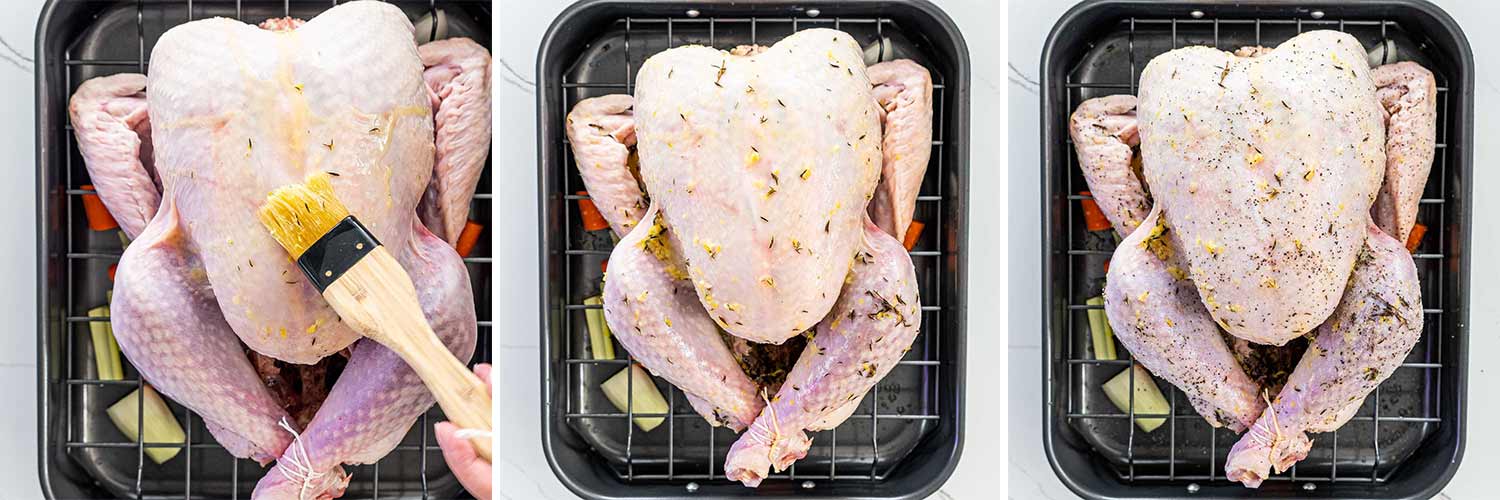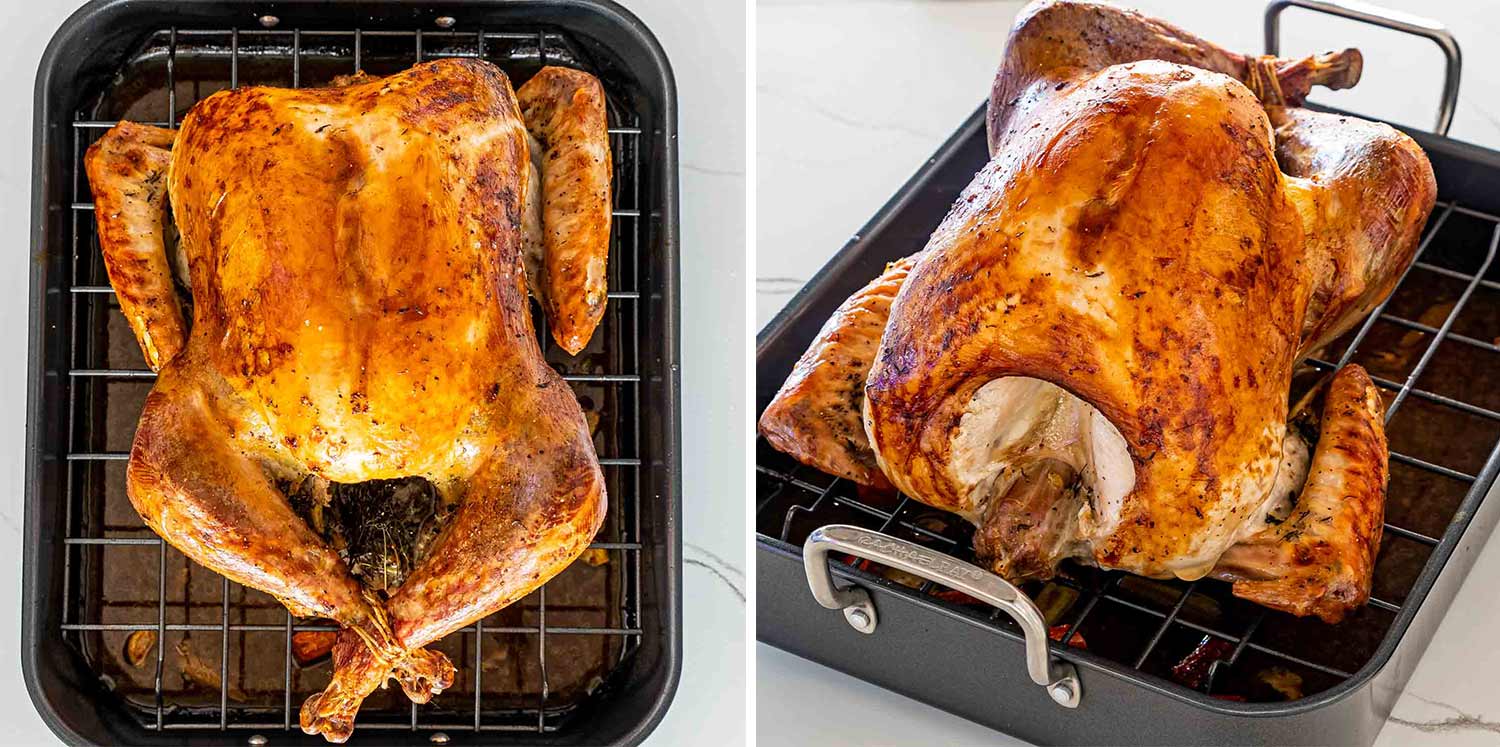How to Roast a Turkey – learn easy techniques to perfectly roast a turkey. Step by step instructions from start to finish.
As Thanksgiving approaches, home cooks everywhere are gearing up to roast the star of the holiday meal – the turkey. But with so many different oven settings, it can get confusing. Should you cook your turkey on bake or roast? And does it really make a difference? Let’s find out.
Choosing Between Bake and Roast
Most modern ovens have multiple settings like bake, roast, convection bake, convection roast, and more. So what do each of these options mean and how do you decide which one to use?
The bake setting turns on the heat from the bottom oven element. It’s designed for foods that need a crisp bottom crust like cookies pizza, casseroles, and more.
The roast setting uses heat from both the top and bottom oven elements. This surrounds the food in even steady heat which is perfect for meats like turkey, chicken, and roasts.
So for turkey, the roast setting is definitely the way to go. It evenly cooks the bird from both sides, ensuring a juicy interior and crisp, brown skin. The bake setting can lead to uneven cooking since the heat only comes from below.
Convection Oven vs Standard Oven
If your oven has a convection setting, that’s another great option for turkey. Convection ovens have a fan that circulates hot air around the cavity. This airflow cooks food faster and more evenly.
In a convection oven, turkey will roast up to 25% faster. You’ll get crispy skin, moist meat, and evenly cooked stuffing in less time. Just be sure to lower the temperature by 25 degrees compared to the standard roast setting.
Regardless of whether you use convection or not, the most important thing is monitoring the turkey’s temperature. Cook until the thickest part of the thigh reaches 165°F. The breast and stuffing should reach 170°F and 165°F respectively.
Using a meat thermometer takes the guesswork out and prevents you from over or undercooking.
Roasting Tips for Perfectly Cooked Turkey
Follow these simple tips for roast turkey success:
-
Start with a fully thawed turkey. Roasting a frozen bird risks uneven cooking. Thaw turkey in the fridge 1-2 days ahead.
-
Use a roasting pan with a rack. The rack elevates the turkey above the pan drippings for even roasting.
-
Pat turkey dry and rub it all over with oil or butter. This helps achieve crispy browned skin.
-
Roast breast side up on the lower rack, centered in the oven.
-
Cook stuffing separately. For food safety, cook stuffing in a casserole dish until it reaches 165°F.
-
Baste with pan drippings 2-3 times during roasting. This adds flavor and moisture.
-
Tent with foil if browning too quickly. Cover wings, legs and breast bone with foil as needed.
-
Let rest before carving. Allowing the turkey to rest for 15-30 minutes after roasting allows juices to absorb back into the meat.
Handy Time and Temperature Guidelines
For perfect results, follow these time and temp guidelines. Keep in mind that a stuffed turkey will take longer:
| Turkey Weight | Roast Temp | Approximate Roasting Time |
|---|---|---|
| 8 to 12 lbs | 325°F | 23⁄4 to 3 hours |
| 12 to 14 lbs | 325°F | 3 to 33⁄4 hours |
| 14 to 18 lbs | 325°F | 33⁄4 to 41⁄4 hours |
| 18 to 20 lbs | 325°F | 41⁄4 to 41⁄2 hours |
| 20 to 24 lbs | 325°F | 41⁄2 to 5 hours |
Always use a meat thermometer to confirm temperatures:
- Thigh – 165°F
- Breast – 170°F
- Stuffing – 165°F
For a convection oven, reduce cook time by 25% and lower temperature to 300°F. Monitor temperature closely and tent turkey if browning too quickly.
Step-By-Step Guide to Roasting Turkey
Follow these simple steps for perfectly roasted turkey:
-
Thaw turkey completely in fridge 1-2 days before roasting. Cook directly from frozen is not recommended.
-
Remove giblets from cavity. Reserve for gravy or discard. Rinse turkey inside and out with cold water and pat very dry with paper towels.
-
Combine 1⁄2 cup butter or oil with desired seasonings. Loosen skin from breast and rub seasoning mixture all over turkey under skin. Rub skin all over with oil or butter.
-
Place turkey breast side up on a rack in a roasting pan. Tuck wings under back. Insert meat thermometer deep into the thickest part of thigh without touching bone.
-
Roast in a 325°F oven on lower rack. Baste with pan drippings every 45 minutes. For convection oven, use 300°F.
-
Once turkey reaches desired internal temperature, remove from oven. Cover loosely with foil and let rest 15-30 minutes before carving.
-
Enjoy your perfectly cooked, mouthwatering roast turkey!
Get Creative with Flavor
Plain turkey is passé. Today’s cooks are kicking up their roast birds with creative flavors. Try one of these flavor ideas:
-
Citrus – Orange, lemon, lime juices or slices under the skin or stuff citrus slices inside the cavity.
-
Herbs – Stuff with rosemary, thyme, sage. Rub minced garlic and herbs under skin.
-
Spice blends – Cajun seasoning, jerk seasoning, curry powder, chili powder, five spice.
-
Aromatics – Stuff cavity with quartered onions, apples, fennel, fresh cranberries.
-
Rub – Coat with brown sugar, smoked paprika, cumin, coriander, mustard and oil.
-
Brine – Soak turkey overnight in a saltwater solution to deeply season and retain moisture.
Don’t be afraid to try new flavor combos until you discover your family’s new favorite roasted turkey!
Make It a Memorable Meal
A perfectly roasted turkey is sure to be the star of your Thanksgiving feast. But don’t forget the delicious array of side dishes that complete the meal. Try these tasty Thanksgiving favorites:
- Fluffy mashed potatoes
- Savory stuffing or dressing
- Sweet potato casserole with toasted marshmallows
- Classic green bean casserole
- Cranberry sauce – either jellied from a can or homemade
- Dinner rolls and biscuits
- Cornbread, pumpkin, pecan or apple pie for dessert
Set your beautiful Thanksgiving table with candles, flowers, runners and your best dishes. Share heartfelt toasts with loved ones. And most importantly, relax and savor the special experience. The secret ingredients for a perfect Thanksgiving are the people you share it with!
FAQs
Still have some questions about roasting turkey? Here are answers to some frequently asked questions:
Should I brine my turkey?
Brining is soaking turkey in a saltwater solution before cooking. It seasons the meat and helps it retain moisture. Brining is optional but can make turkey more flavorful and juicy.
Do I need to baste my turkey?
Basting helps keep the turkey moist and adds flavor. When roasting turkey, baste every 30-45 minutes after the first hour using the juices in the bottom of the pan.
When do I remove the bag of giblets?
Check both cavities as soon as you remove turkey from packaging and discard bag of giblets. Cook giblets separately to use for gravy.
What temperature should turkey be when done?
Cook until deep thigh meat reaches 165°F. Breast should reach 170°F and stuffing 165°F for food safety.
Can I stuff my turkey?
For safety and even cooking, it’s best to cook stuffing separately in a baking dish. However, if you do stuff, the center of the stuffing must reach 165°F.
How long should I let turkey rest before carving?
Letting roasted turkey rest for 15-30 minutes allows juices to absorb back into the meat. Always use a meat thermometer for perfectly cooked results.
The Takeaway
Cooking the Thanksgiving turkey can feel daunting, but have no fear! By roasting your bird in the oven on the roast setting, monitoring temperature carefully, and using a few simple roasting tips, you’ll achieve a mouthwatering main course. Experiment with fun new flavors to make it truly memorable. And most importantly, relax and enjoy time with loved ones over an amazing meal. Here’s to a very happy Thanksgiving!
:max_bytes(150000):strip_icc()/Roastingaturkey2500-5a12753c22fa3a003680959c.jpg)
Make The Herb Butter Mixture

In a small saucepan melt the butter over medium heat. Add the lemon zest and juice and the teaspoon of thyme to the butter and stir. Set aside.

First, you’ll need to place the onions, celery and carrots in the bottom of a roasting rack, then place the rack on top. Place the turkey breast side up on top of the roasting rack.
Tuck the wing tips under the body of the turkey, this will help stabilize the turkey when carving, plus it makes it easier to carve the breast. Tie the legs together with butcher twine.

Brush the turkey with the butter mixture generously over the entire turkey. Use all the butter. Next, you’ll want to season it with salt and pepper all around. Make sure to season a bit inside the cavity as well.
You can pour a little of water in the bottom of the roasting pan, but keep in mind the turkey will release drippings as well as it cooks. However, if you’re making gravy, it’s best to add about a cup of water to the roasting pan.
Uncover And Finish Roasting

Continue roasting for an additional 1½ hours until the turkey turns golden brown and is fully cooked inside. You can baste it every 30 minutes if preferred. The turkey is done when the thigh meat reaches an internal temperature of 180°F and the breast reaches 165°F.
